|
by
kirupa | 22 November 2008
In the
previous page, you converted your image into a
button and edited the button's template. In this
page, we will wrap things up by adding the rollover
effects that you need.
Ok, you are now ready
to make visual changes that appear when you interact with
your button. Each such visual change is represented
by what is known as a State. You can view the states
your button currently has defined by looking at your States panel found in the Interaction pane:
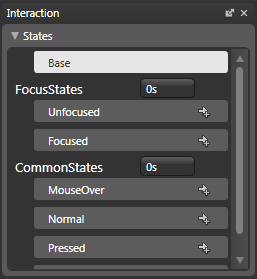
[ the Interaction panel contains the states that
your button exposes ]
Because the control in question is
a Button, the internals of your Button class contain
states for Unfocused, Focused, MouseOver, Normal,
Pressed, and Disabled. What this means is that, when
your button is (for example) disabled, then your
button will find itself in the Disabled state and
have the look that this state defines. The same
applies for all of the other states you see
displayed.
There is an odd one though. You also have a state known as Base, and this
base state is how your control would look like if
you did absolutely nothing to it. It is the default
state that gets selected initially and the state you
will always return to if you want to make
modifications that go beyond just the limited
lifespan of a single state.
The states we are interested in are the ones for
MouseOver and Pressed. The Normal state is important
as well, but we'll just leave it equivalent to that
of our Base state. In other words, when a state is not modified, its
properties are equivalent to the properties
specified as part of your Base state.
Let's deal with our MouseOver state first. With
your mouse, click on the MouseOver entry in your
States panel:
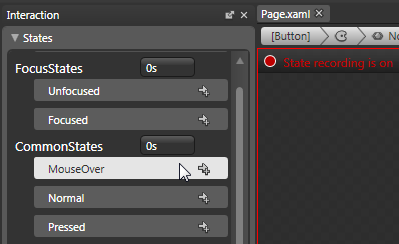
[ click on the MouseOver state first ]
When you click on it, notice that you will go
into the State recording mode. This means that any
changes you make to your artboard will only be
reflected in the state you are currently editing. In
this case, any modifications you make will only be
visible when your button is in the MouseOver state.
Anyway, select your image on the artboard. With
the image selected, make it smaller by resizing it
using the adorners. Be sure to hold down the Alt key
to constrain your current aspect ratio and scale
from the center:
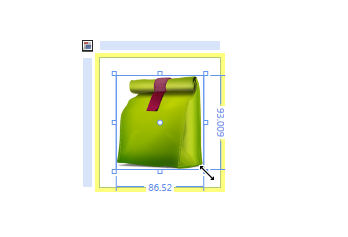
[ make your image smaller ]
That's all there is to it. From your States
panel, if you click on your Base state, notice that
your image is larger and back to its original size.
When you click on MouseOver, the image shrinks to
the size you gave it a few seconds ago.
If you hit F5 and preview the animation, notice
that your image shrinks in size when you hover it -
just like you want:
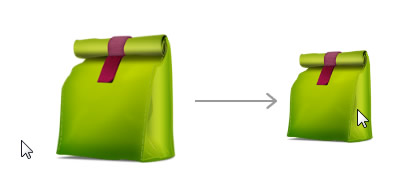
[ when you preview, your image gets smaller when you
mouse over it ]
The only state we have remaining is the Pressed
state. From your States panel, select your Pressed
state. What we want to do is make our image small
just like before. The only variation is that the
image will be scaled down to be even smaller!
Use the resize adorners in conjunction with the
Alt key to make your image smaller than what it was
in the earlier MouseOver state:
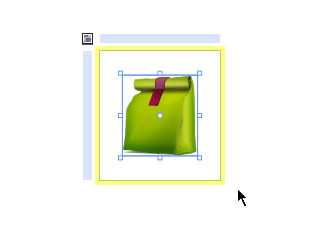
[ your image is even smaller in the Pressed state ]
If you test your animation now, your button will
shrink in size when you hover over it, and when you
press down on your mouse, the button will shrink
even further. Great.
There is one last thing that needs to be done. If
you noticed, the transition between your
Base/Normal, MouseOver, and Pressed states is very
sudden. Ideally, you want to give your animation a
chance to gracefully go from one state to another
without suddenly jumping to it.
The solution to this is very simple. You need
give your Visual State Group your states are under a
duration. The states that you modified are all under
the CommonStates state group:
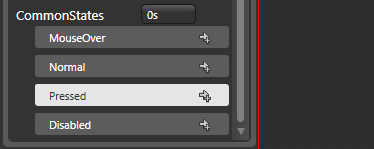
[ a duration given to a state group carries over to
all states within that group ]
To the right of your CommonStates State Group
name, you will see a text field that you can specify
the duration of your states. Change the value from
0s to .2 (or .2s):
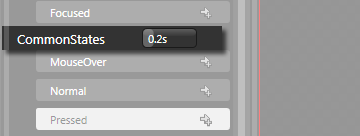
[ enter a .2 in the duration field next to
CommonStates ]
If you preview your animation now, you will
notice that the jump between the various states
occurs more gradually - .2 seconds more gradually to
be precise.
Phew - you are now done! If you want to continue
modifying more of your Button's template, be sure to
return to the Base state first unless you want your
modifications to be visible only in the state you
currently have selected.
To return to your main application and make
changes outside of your template, simply use the
breadcrumb bar to return to your root Page.xaml's
UserControl:
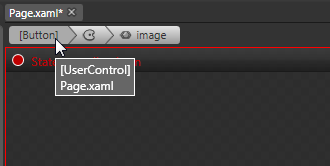
[ you can go back to the root of your UserControl by
using the breadcrumb bar ]
This
tutorial took you through a whirlwind tour of
various little things that you needed to do to have
an image change how it looks when you interact with
it. I have posted the source file to my version of
what you just created, so download it from the below
location:
Just a final word before we wrap up. If you have a question and/or want to be part of a friendly, collaborative community of over 220k other developers like yourself, post on the forums for a quick response!

|